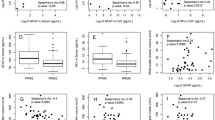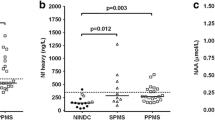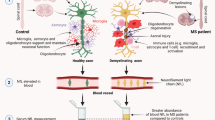Abstract
Although current evidence mainly suggests immunopathogenesis of demyelination and neurodegeneration in multiple sclerosis (MS), there are results which document the importance of other factors, such as oxidative stress and its mediated injuries. The oxidative stress intensity in axonal damage during acute demyelination is little known. We performed this study as a cross-sectional biomarker validation study in order to evaluate the parameters of axonal damage (phosphorylated neurofilaments heavy chain (pNF-H)) and oxidative stress (8-hydroxy-2′-deoxyguanosine (8-OHdG)) in plasma of patients with initial and relapsing-remitting demyelination attacks, defined as clinically isolated syndrome (CIS) and relapsing-remitting multiple sclerosis (RRMS); and the correlations between these parameters and biological (index of blood brain barrier (BBB) permeability), clinical (index of disease progression), and radiological (T1-Gd-enhancing lesion volume) activities of disease. Both parameters were increased in CIS and RRMS compared to control subjects (p < 0.05). The positive correlations were observed between 8-OHdG values and index of BBB permeability, clinical severity of disease, and demyelinated brain lesion volume, in CIS group (r > 0.50; p < 0.05). Similar correlations were obtained between pNF-H values and the above parameters, as well as the index of disease progression, in RRMS group (r > 0.30; p < 0.05). There was a significant correlation between values of 8-OHdG and pNF-H only in CIS group, r = 0.52, p < 0.05. While the plasma values of 8-OHdG reflect the degree of acute demyelination in CIS, pNF-H values reflect that in RRMS. The obtained results must be reevaluated in similar prospective studies related to their prognostic values.





Similar content being viewed by others
References
Brettschneider J, Petzold A, Junker A, Tumani H (2006) Axonal damage markers in the cerebrospinal fluid of patients with clinically isolated syndrome improve predicting conversion to definite multiple sclerosis. Multip Scler 12:143–148
Cai JY, Lu C, Chen MH, Ba HJ, Chen XD, Lin JH, Sun J (2013) Predictive value of phosphorylated axonal neurofilament subunit H for clinical outcome in patients with acute intracerebral hemorrhage. Clin Chim Acta 424:182–186
Chang A, Tourtelotte WW, Rudick R, Trapp BD (2002) Premyelinating oligodendrocytes in chronic lesions of multiple sclerosis. New Engl J Med 346:165–173
Coleman M (2005) Axon degeneration mechanisms: commonality amid diversity. Nat Rev Neurosci 6:889–898
Dale JM, Garcia ML (2012) Neurofilament phosphorylation during development and disease: which came first, the phosphorylation or the accumulation? J Amino Acids. doi:10.1155/2012/382107
de Bock L, Fraussen J, Villar LM, Alvarez-Cermeno JC, van Wijmeersch B, van Pesch V, Stinissen P, Somers V (2016) Anti-SPAG16 antibodies in primary progressive multiple sclerosis are associated with an elevated progression index. Eur J Neurol 23:722–728
Dutta R, Trapp BD (2011) Mechanisms of neuronal dysfunction and degeneration in multiple sclerosis. Prog Neurobiol 93:1–12
Eikelenboom MJ, Petzold A, Lazeron RH, Silber E, Sharief M, Thompson EJ, Barkhof F, Giovannoni G, Polman CH, Uitdehaag BM (2003) Multiple sclerosis: neurofilament light chain antibodies are correlated to cerebral atrophy. Neurology 60:219–223
Fressinaud C, Berges R, Eyer J (2012) Axon cytoskeleton proteins specifically modulate oligodendrocyte growth and differentiation in vitro. Neurochem Int 60:78–90
Friese MA, Schattling B, Fugger L (2014) Mechanisms of neurodegeneration and axonal dysfunction in multiple sclerosis. Nat Rev Neurol 10(4):225–238
Gunnarsson M, Malmeström C, Axelsson M, Sundström P, Dahle C, Vrethem M, Olsson T, Piehl F, Norgren N, Rosengren L, Svenningsson A, Lycke J (2011) Axonal damage in relapsing multiple sclerosis is markedly reduced by natalizumab. Ann Neurol 69:83–89
Haider L, Fischer MT, Frischer JM, Bauer J, Höftberger R, Botond G, Esterbauer H, Binder CJ, Witztum JL, Lassmann H (2011) Oxidative damage in multiple sclerosis lesions. Brain 134:1914–1924
Jacob KD, Hooten NN, Trzeciak AR, Evans MK (2013) Markers of oxidant stress that are clinically relevant in aging and age-related disease. Mech Ageing Dev 134:139–157
Jung C, Lee S, Ortiz D, Zhu Q, Julien JP, Shea TB (2005) The high and middle molecular weight neurofilament subunits regulate the association of neurofilaments with kinesin: inhibition by phosphorylation of the high molecular weight subunit. Mol Brain Res 141(2):151–155
Koch MW, Ramsaransing GS, Arutjunyan AV, Stepanov M, Teelken A, Heersema DJ, De Keyser J (2006) Oxidative stress in serum and peripheral blood leukocytes in patients with different disease courses of multiple sclerosis. J Neurol 253:483–487
Kuhle J, Leppert D, Petzold A, Regeniter A, Schindler C, Mehling M, Anthony DC, Kappos L, Lindberg RL (2011) Neurofilament heavy chain in CSF correlates with relapses and disability in multiple sclerosis. Neurology 76:1206–1213
Kurtzke JF (1983) Rating neurologic impairment in multiple sclerosis: an expanded disability status scale (EDSS). Neurology 33:1444–1452
Lassmann H, Bruck W, Lucchinetti CF (2007) The immunopathology of multiple sclerosis: an overview. Brain Pathol 17:210–218
Ljubisavljevic S (2016) Oxidative stress and neurobiology of demyelination. Mol Neurobiol 53(1):744–758
Lublin FD, Reingold SC (1996) Defining the clinical course of multiple sclerosis: results of an international survey— National multiple sclerosis society (USA) advisory committee on clinical trials of new agents in multiple sclerosis. Neurology 46:907–911
Medana IM, Esiri MM (2003) Axonal damage: a key predictor of outcome in human CNS diseases. Brain 126:515–530
Petzold A (2005) Neurofilament phosphoforms: surrogate markers for axonal injury, degeneration and loss. J Neurol Sci 233:183–198
Petzold A, Eikelenboom MJ, Keir G, Grant D, Lazeron RHC, Polman CH, Uitdehaag BMJ, Thompson EJ, Giovannoni G (2005) Axonal damage accumulates in the progressive phase of multiple sclerosis: three year follow up study. J Neurol Neurosurg Psychiatry 76:206–211
Petzold A, Mondria T, Kuhle J, Rocca MA, Cornelissen J, te Boekhorst P, Lowenberg B, Giovannoni G, Filippi M, Kappos L, Hintzen R (2010) Evidence for acute neurotoxicity after chemotherapy. Ann Neurol 68:806–815
Polman CH, Reingold SC, Banwell B, Clanet M, Cohen JA, Filippi M, Fujihara K, Havrdova E, Hutchinson M, Kappos L, Lublin FD, Montalban X, O’Connor P, Sandberg-Wollheim M, Thompson AJ, Waubant E, Weinshenker B, Wolinsky JS (2011) Diagnostic criteria for multiple sclerosis: 2010 revisions to the McDonald criteria. Ann Neurol 69(2):292–302
Rejdak K, Eikelenboom MJ, Petzold A, Thompson EJ, Stelmasiak Z, Lazeron RH, Barkhof F, Polman CH, Uitdehaag BM, Giovannoni G (2004) CSF nitric oxide metabolites are associated with activity and progression of multiple sclerosis. Neurology 63:1439–1445
Tasset I, Aguera E, Sánchez-López F, Feijóo M, Giraldo AI, Cruz AH, Gascón F, Túnez I (2012) Peripheral oxidative stress in relapsing–remitting multiple sclerosis. Clin Biochem 45:440–444
Teunissen CE, Khalil M (2012) Neurofilaments as biomarkers inmultiple sclerosis. Mult Scler J 18(5):552–556
Turkez H, Togar B, Di Stefano A, Taspınar N, Sozio P (2015) Protective effects of cyclosativene on H2O2-induced injury in cultured rat primary cerebral cortex cells. Cytotechnology 67(2):299–309
Acknowledgments
This work was supported by the Grant from the scientific project number 41018 financed by the Ministry of Education and Science, Republic of Serbia. Authors thank Svetlana Stojanovic, Slobodan Vojinovic, and Dragan Stojanov, for the support in the laboratory, clinical, and radiological work.
Author information
Authors and Affiliations
Corresponding author
Ethics declarations
Conflict of interest
No conflict of interest exists for any of the authors listed in the article.
Rights and permissions
About this article
Cite this article
Ljubisavljevic, S., Stojanovic, I., Basic, J. et al. The Validation Study of Neurofilament Heavy Chain and 8-hydroxy-2′-deoxyguanosine as Plasma Biomarkers of Clinical/Paraclinical Activity in First and Relapsing-Remitting Demyelination Acute Attacks. Neurotox Res 30, 530–538 (2016). https://doi.org/10.1007/s12640-016-9639-z
Received:
Revised:
Accepted:
Published:
Issue Date:
DOI: https://doi.org/10.1007/s12640-016-9639-z




